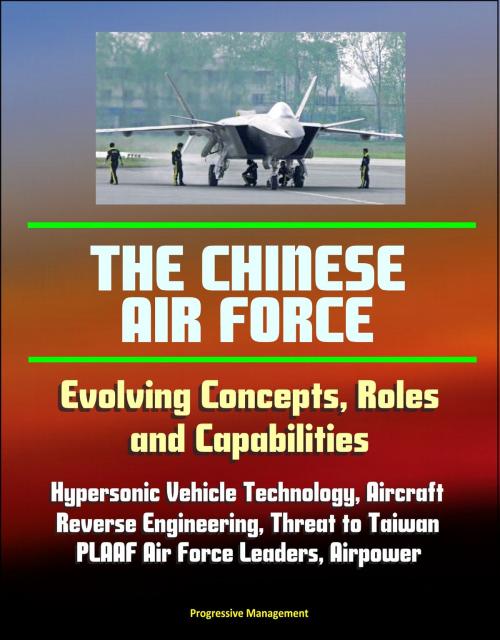The Chinese Air Force: Evolving Concepts, Roles, and Capabilities - Hypersonic Vehicle Technology, Aircraft, Reverse Engineering, Threat to Taiwan, PLAAF Air Force Leaders, Airpower
Nonfiction, Social & Cultural Studies, Political Science, Politics, Arms Control, History, Military, Aviation| Author: | Progressive Management | ISBN: | 9781310789472 |
| Publisher: | Progressive Management | Publication: | February 4, 2014 |
| Imprint: | Smashwords Edition | Language: | English |
| Author: | Progressive Management |
| ISBN: | 9781310789472 |
| Publisher: | Progressive Management |
| Publication: | February 4, 2014 |
| Imprint: | Smashwords Edition |
| Language: | English |
This vital report from a distinguished international group of experts on airpower, military affairs, and the People's Republic of China PRC - Taiwan relationship examines the present state and future prospects of the People's Liberation Army Air Force (PLAAF). The report was produced by the Center for the Study of Chinese Military Affairs (CSCMA) of the National Defense University.
In the ongoing military buildup by the People's Republic of China, one of the crucial areas of concern is the force disparity between the PRC and Taiwan. The traditional technological edge that Taiwan's military air-power forces enjoyed over the mainland is a thing of the past. Where a decade ago, Taiwan's airmen flew aircraft that were at least one, and in some cases two, technological generations superior to those of the PRC, today they are already in a position of inferiority, with their aging F-16A/B, AIDC F-CK-1 Ching-Kuo, and Mirage 2000 fighters increasingly outclassed and outnumbered by newer PRC aircraft such as the Su-27, J-10, J-11, and Su-30 aircraft. Where a decade ago, Taiwan's airmen could operate with relative impunity over the Taiwan Strait, facing a limited-range surface-to-air missile threat built around derivatives of the then 40-year-old Khrushchev-era SA-2, today they face far more dangerous S-300 (SA-10/20) systems that deny access over the strait, and the prospect of the S-400 which, installed along the coast of the PRC, will reach across the strait and beyond Taiwan itself. Coupled with the PRC's introduction of precision air-to-surface munitions, air refueling, airborne early warning, large numbers of short- and medium-range ballistic missiles, land attack cruise missiles, and an increased emphasis on electronic and cyber warfare, the challenges facing Taiwan's air defenders have never been graver than at the present time. Significantly, because of the longstanding ties between the United States and Taiwan, any prospect of cross-strait conflict carries with it the implicit risk of igniting a broader and even more devastating conflict. Clearly, it is in the interest of all parties to ensure that the PRC-Taiwan relationship evolves in a peaceful, mutually beneficial fashion. Beijing's missile-centric strategy presents a number of challenges for regional stability. Barring the fielding of effective countermeasures, Chinese conventional aerospace power, specifically short- and medium-range ballistic and extended-range land attack cruise missiles, may over time give the PLA a decisive advantage in future conflicts around China's periphery.
Contents: Foreword * I: CONCEPTS * Chapter 1 - The Concept of Airpower: Its Emergence, Evolution, and Future * Chapter 2 - China's Quest for Joint Aerospace Power: Concepts and Future Aspirations * Chapter 3 - The PLAAF's Evolving Influence within the PLA and upon National Policy * II: ORGANIZATION, LEADERSHIP, AND DOCTRINE * Chapter 4 - The Organizational Structure of the PLAAF * Chapter 5 - The Missions of the People's Liberation Army Air Force * Chapter 6 - The Development of the PLAAF's Doctrine * Chapter 7 - The PLAAF and the Integration of Air and Space Power * III: EQUIPMENT, PERSONNEL, AND EDUCATION / TRAINING * Chapter 8 - Equipping the PLAAF: The Long March to Modernity * Chapter 9 - Meeting the Challenge of the Upcoming PLAAF Leadership Reshuffle * Chapter 10 - Education and Training in the PLAAF * IV: INDUSTRIES AND MILITARY IMPLICATIONS * Chapter 11 - China's Aviation Industry: Past, Present, and Future * Chapter 12 - China's Quest for Advanced Aviation Technologies * Chapter 13 - The Employment of Airpower in the Taiwan Strait * Chapter 14 - The U.S.-China Military Balance Seen in a Three-Game Framework
This vital report from a distinguished international group of experts on airpower, military affairs, and the People's Republic of China PRC - Taiwan relationship examines the present state and future prospects of the People's Liberation Army Air Force (PLAAF). The report was produced by the Center for the Study of Chinese Military Affairs (CSCMA) of the National Defense University.
In the ongoing military buildup by the People's Republic of China, one of the crucial areas of concern is the force disparity between the PRC and Taiwan. The traditional technological edge that Taiwan's military air-power forces enjoyed over the mainland is a thing of the past. Where a decade ago, Taiwan's airmen flew aircraft that were at least one, and in some cases two, technological generations superior to those of the PRC, today they are already in a position of inferiority, with their aging F-16A/B, AIDC F-CK-1 Ching-Kuo, and Mirage 2000 fighters increasingly outclassed and outnumbered by newer PRC aircraft such as the Su-27, J-10, J-11, and Su-30 aircraft. Where a decade ago, Taiwan's airmen could operate with relative impunity over the Taiwan Strait, facing a limited-range surface-to-air missile threat built around derivatives of the then 40-year-old Khrushchev-era SA-2, today they face far more dangerous S-300 (SA-10/20) systems that deny access over the strait, and the prospect of the S-400 which, installed along the coast of the PRC, will reach across the strait and beyond Taiwan itself. Coupled with the PRC's introduction of precision air-to-surface munitions, air refueling, airborne early warning, large numbers of short- and medium-range ballistic missiles, land attack cruise missiles, and an increased emphasis on electronic and cyber warfare, the challenges facing Taiwan's air defenders have never been graver than at the present time. Significantly, because of the longstanding ties between the United States and Taiwan, any prospect of cross-strait conflict carries with it the implicit risk of igniting a broader and even more devastating conflict. Clearly, it is in the interest of all parties to ensure that the PRC-Taiwan relationship evolves in a peaceful, mutually beneficial fashion. Beijing's missile-centric strategy presents a number of challenges for regional stability. Barring the fielding of effective countermeasures, Chinese conventional aerospace power, specifically short- and medium-range ballistic and extended-range land attack cruise missiles, may over time give the PLA a decisive advantage in future conflicts around China's periphery.
Contents: Foreword * I: CONCEPTS * Chapter 1 - The Concept of Airpower: Its Emergence, Evolution, and Future * Chapter 2 - China's Quest for Joint Aerospace Power: Concepts and Future Aspirations * Chapter 3 - The PLAAF's Evolving Influence within the PLA and upon National Policy * II: ORGANIZATION, LEADERSHIP, AND DOCTRINE * Chapter 4 - The Organizational Structure of the PLAAF * Chapter 5 - The Missions of the People's Liberation Army Air Force * Chapter 6 - The Development of the PLAAF's Doctrine * Chapter 7 - The PLAAF and the Integration of Air and Space Power * III: EQUIPMENT, PERSONNEL, AND EDUCATION / TRAINING * Chapter 8 - Equipping the PLAAF: The Long March to Modernity * Chapter 9 - Meeting the Challenge of the Upcoming PLAAF Leadership Reshuffle * Chapter 10 - Education and Training in the PLAAF * IV: INDUSTRIES AND MILITARY IMPLICATIONS * Chapter 11 - China's Aviation Industry: Past, Present, and Future * Chapter 12 - China's Quest for Advanced Aviation Technologies * Chapter 13 - The Employment of Airpower in the Taiwan Strait * Chapter 14 - The U.S.-China Military Balance Seen in a Three-Game Framework















